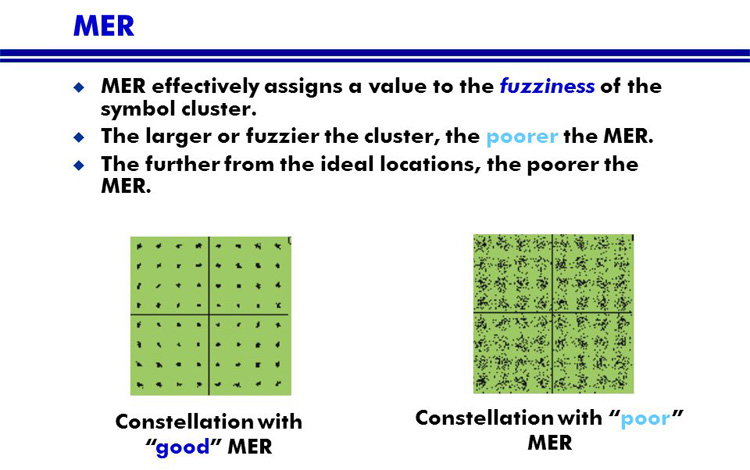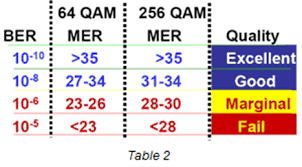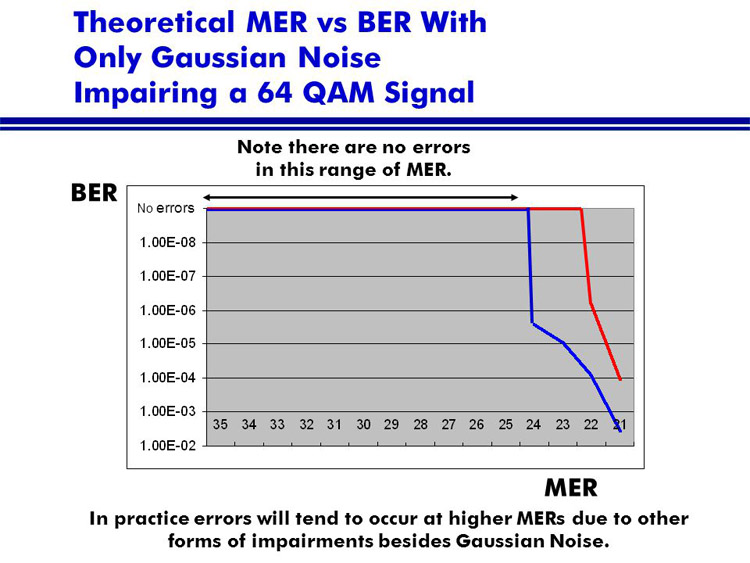MER: The modulation error ratio, which is the ratio of the effective value of the vector magnitude to the effective value of the error magnitude on the constellation diagram (the ratio of the square of the ideal vector magnitude to the square of the error vector magnitude). It is one of the main indicators to measure the quality of digital TV signals. It is of great significance to the logarithmic measurement results of the distortion superimposed on the digital modulation signal. It is similar to the signal-to-noise ratio or carrier-to-noise ratio used in the analog system. It is a judgment system Critical part of failure tolerance. Other similar indicators such as BER bit error rate, C/N carrier-to-noise ratio, power level average power, constellation diagram, etc.
The value of MER is expressed in dB, and the larger the value of MER, the better the signal quality. The better the signal, the closer the modulated symbols are to the ideal position, and vice versa. The test result of MER reflects the ability of the digital receiver to restore the binary number, and there is an objective signal-to-noise ratio (S/N) similar to that of the baseband signal. The QAM-modulated signal is output from the front end and enters the home through the access network. The MER indicator will gradually deteriorate. In the case of constellation diagram 64QAM, the empirical threshold value of MER is 23.5dB, and in 256QAM it is 28.5dB (the front-end output should be If it is higher than 34dB, it can ensure that the signal enters the home normally, but it does not rule out the abnormality caused by the quality of the transmission cable or the sub-front end). If it is lower than this value, the constellation diagram will not be locked. MER indicator front-end modulation output requirements: For 64/256QAM, front-end > 38dB, sub-front-end > 36dB, optical node > 34dB, amplifier > 34dB (secondary is 33dB), user end > 31dB (secondary is 33dB), above 5 A key MER point is also often used to find cable TV line problems.
Significance of MER MER is considered as a form of SNR measurement, and the meaning of MER is:
①. It includes various types of damage to the signal: noise, carrier leakage, IQ amplitude imbalance, and phase noise.
②. It reflects the ability of digital functions to restore binary numbers; it reflects the degree of damage to digital TV signals after being transmitted through the network.
③. SNR is a baseband parameter, and MER is a radio frequency parameter.
When the signal quality degrades to a certain level, the symbols will eventually be decoded incorrectly. At this time, the actual bit error rate BER increases. BER (Bit Error Rate): Bit error rate, defined as the ratio of the number of error bits to the total number of bits. For binary digital signals, since binary bits are transmitted, the bit error rate is called the bit error rate (BER).
BER = Error Bit Rate/Total Bit Rate.
BER is generally expressed in scientific notation, and the lower the BER, the better. When the signal quality is very good, the BER values before and after error correction are the same; but in the case of certain interference, the BER values before and after error correction are different, and after error correction The bit error rate is lower. When the bit error is 2×10-4, partial mosaic appears occasionally, but it can still be viewed; the critical BER is 1×10-4, a large number of mosaics appear, and the image playback appears intermittent; BER greater than 1×10-3 cannot be viewed at all. watch. The BER index is only of reference value and does not fully indicate the status of the entire network equipment. Sometimes it is only caused by a sudden increase due to instantaneous interference, while MER is completely opposite. The entire process can be used as a data error analysis. Therefore, MER can provide early warning for signals. When the signal quality decreases, MER will decrease. With the increase of noise and interference to a certain extent, MER will gradually decrease, while BER remains unchanged. Only when interference increases to a certain extent, MER The BER begins to deteriorate when the MER drops continuously. When the MER drops to the threshold level, the BER will drop sharply.
Post time: Feb-23-2023




